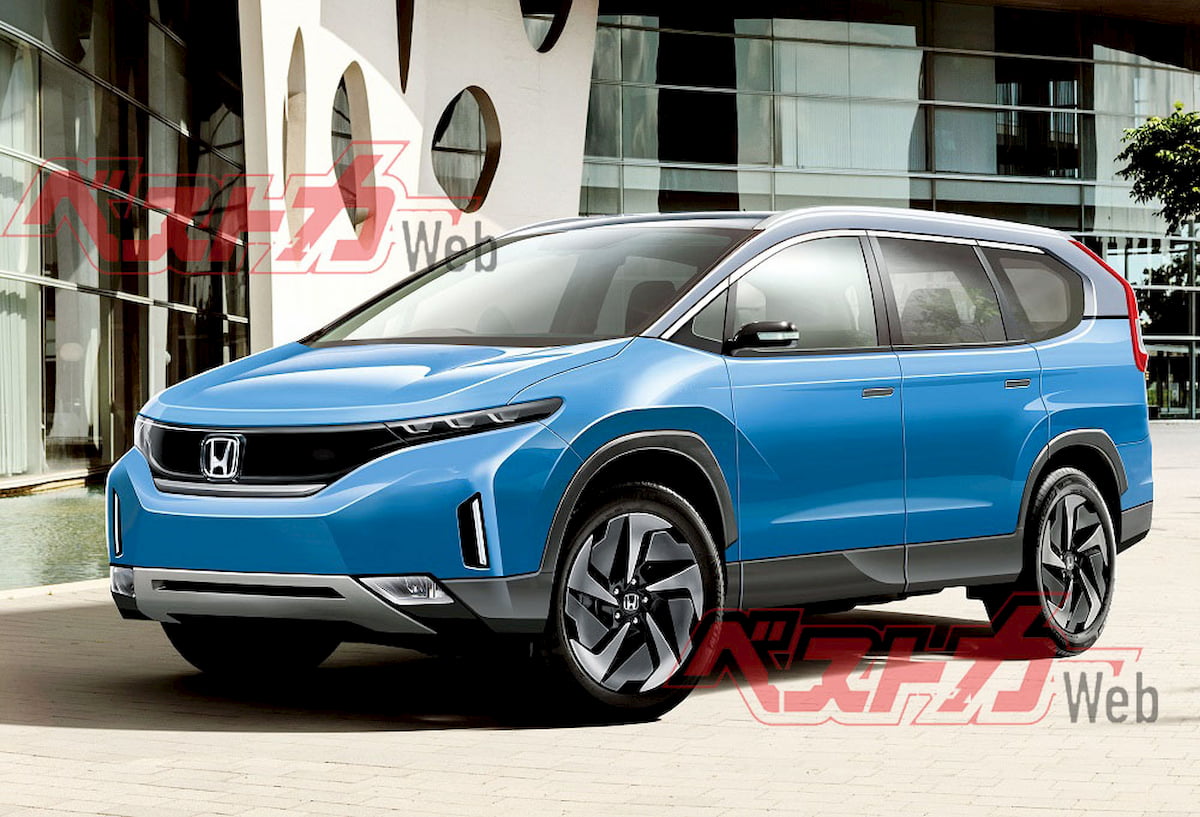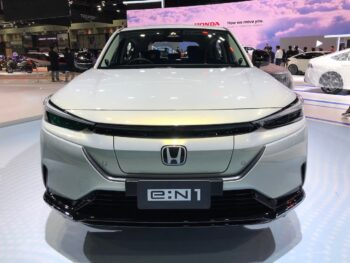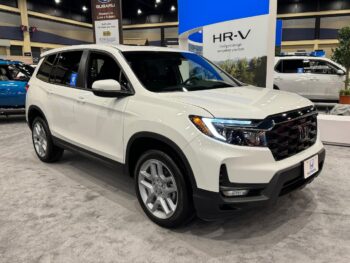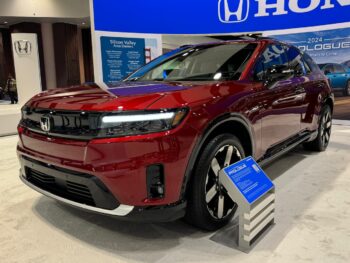Update: ‘Battery partnership’ sub-section of ‘Indigenously developed Honda CR-V EV’ and ‘Honda EV goals for North America’ section updated and ‘TopElectricSUV says’ section added.
Speculations about a Honda CR-V EV (battery-electric) releasing in 2024 had floated on the web for more than a year, but the announcement of the Honda Prologue electric SUV in 2021 spewed cold water on the old rumors. A Honda CR-V EV will become a reality only in the second half of the decade, and there are two different engineering options for the model. Honda has not made any announcements about a battery-electric CR-V, but here are the possibilities:
1. GM-Honda co-developed Honda CR-V EV
Honda entered an agreement with GM in April 2020 to co-develop two EVs based on GM’s third-gen global EV platform and powered by Ultium batteries first used for the GMC Hummer EV pickup and the Cadillac Lyriq. The first model, the Honda Prologue SUV, will arrive at dealers in early 2024. The second vehicle, the Acura ZDX electric SUV, will debut in 2023 and will begin reaching dealerships shortly after the Prologue. Honda will design the exterior and interior of both vehicles, and its engineers would modify GM’s platform to match the driving characteristics customers typically expect in a Honda.
Honda saw the partnership as a way to quickly put electric vehicles on the road and accelerate its electrification roadmap. The combined manufacturing efficiencies and scale would provide customers with a greater value.
Alliance deepens
Two years after announcing their tie-up, GM and Honda deepened their alliance to include more jointly developed electric vehicles. In an announcement on April 5, 2022, the duo said it will produce millions of EVs, including compact crossover vehicles, starting in 2027. These models will be affordable EVs based on a new global architecture, and they will incorporate GM’s next-gen Ultium battery technology.
The companies (Honda and GM) are working together to enable global production of millions of EVs starting in 2027, including compact crossover vehicles, leveraging the two companies’ technology, design and sourcing strategies.
GM and Honda’s joint announcement on April 5, 2022 via HondaNews.com
A possibility is that the pure-electric compact crossovers Honda and GM plan to make from 2027 as part of the expanded relationship will include a Honda CR-V EV and a Honda HR-V EV. The compact crossover segment is the world’s most popular category, representing annual volumes of 13+ mn vehicles. The CR-V is a top seller in this market segment.
2. Indigenously developed Honda CR-V EV
Following the first two models co-developed with GM, Honda will introduce indigenously developed BEVs based on a new in-house ‘e:Architecture’ beginning in 2026. As per its announcement on April 23, 2021, Honda plans to offer the bespoke EVs developed in-house, first in North America and later in other regions. Given that the CR-V is the best-selling model in the U.S., the company’s most important market in the continent, fully electrifying it or releasing a pure electric alternative would be a priority.
In-house developed Honda EVs still relevant
In a separate announcement on April 5, 2022, Rick Schostek, the Vice President of Corporate Operations at American Honda, confirmed that the expanded partnership with GM for Honda EVs doesn’t mean that EVs developed in-house are no longer in the pipeline. The company is already developing EVs using the Honda e:Architecture, Schostek said. He added that it would align the affordable Honda EV co-developed with GM with the Honda e:Architecture-based EVs.
Schostek said Honda wants to dramatically expand the sales of affordable, compact EVs. That’s where the Japanese automaker can leverage the strength of its relationship with GM. A key factor in deciding to co-develop a new series of affordable EVs with GM was the success of Honda’s design and development teams working with their counterparts from the American automaker on the first projects.
With GM or on a homegrown platform, Honda would need a Honda CR-V EV equivalent to remain relevant in the C-segment that is transitioning to EVs quite quickly. We expect to see a Honda-badged VW ID.4 rival in American showrooms after 2025.
Battery partnership
Honda has partnered with LG Energy Solution to produce batteries for EVs built at its North American plants. This would be a major step forward for the company as it looks to carve out its share of the EV market. The two companies will build a joint venture battery plant with an annual production capacity of ~40 GWh in Fayette County, Ohio. Mass production of pouch-type lithium-ion batteries at this facility will start by the end of 2025.
Expect the Honda Sensing 360 in future CR-V versions
The next-gen CR-V could be among Honda’s first SUVs’ to get Honda Sensing 360, the company’s next-gen advanced safety and driver-assistive system suite. Compared to Honda Sensing, Honda Sensing 360 has an expanded sensing range, and that too, not just in the front and rear, but around the vehicle.
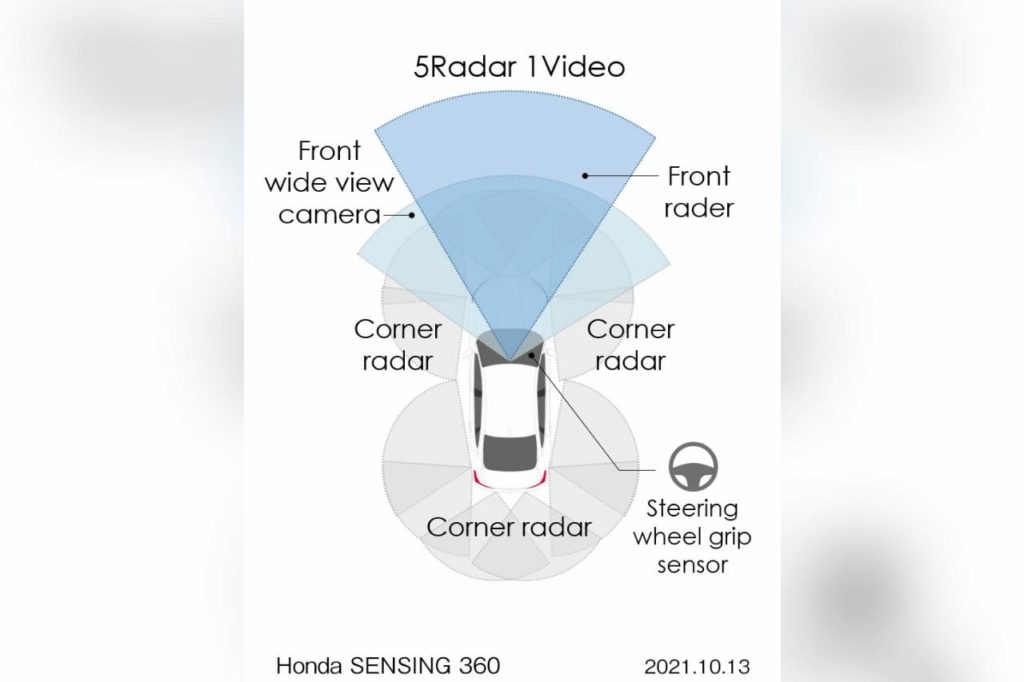
In addition to Honda Sensing’s monocular camera, Honda Sensing 360 uses five millimeter-wave radar sensors in the front and at all the corners of the vehicle. A more advanced Collision Mitigation Braking System (CMBS), Front Cross Traffic Warning, Lane Change Collision Mitigation, Active Lane Change Assist, and Cornering Speed Assist will be the main features of Honda Sensing 360.
Honda EV goals for North America
Honda has announced ambitious targets for electric vehicles. The company plans to have 40% of its sales in North America come from electric vehicles and fuel cell electric vehicles (FCEVs) by 2030. By 2035, Honda wants that number to be 80%. Its ultimate goal is a 100% zero-emission line-up in North America by 2040.
Honda’s EV journey in North America begins with the launch of the GM Ultium platform-based Honda Prologue in 2024. Launching EVs based on the indigenously developed e:Architecture in 2026 will be the second step. Affordable EVs based on a new architecture co-developed with GM will follow in 2027.
Low-volume Honda CR-V FCEV arrives in 2024
In addition, some innovative projects will be developed with a long-term focus. The first of them will be a Honda CR-V FCEV (Hydrogen-powered), a plug-in hybrid that will be usable as a BEV as well, thanks to a larger battery pack. This model will be manufactured at Honda’s Performance Manufacturing Center (PMC) in Marysville, Ohio, in 2024, and Honda will share more details closer to its introduction. The variant will be produced in small volumes.
All the aforementioned electric models would come from North American factories. Currently, 95% of the Honda vehicles sold in the U.S. are North American-made. The Japanese automaker plans to deliver close to 500,000 electric vehicles in North America by 2030.
TopElectricSUV says
As America’s best-selling crossover for more than 25 years, the CR-V is not going to be left behind in Honda’s transition to zero-emission vehicles. For us, it’s a matter of when, not if. The Honda CR-V EV, whenever it arrives, will likely offer a spacious interior, low energy consumption, innovative convenience features, and new ADAS functions. Despite different powertrains, the basic formula for the CR-V’s success is unlikely to change.
Featured image: Render of a future Honda CR-V by BestCar magazine.
